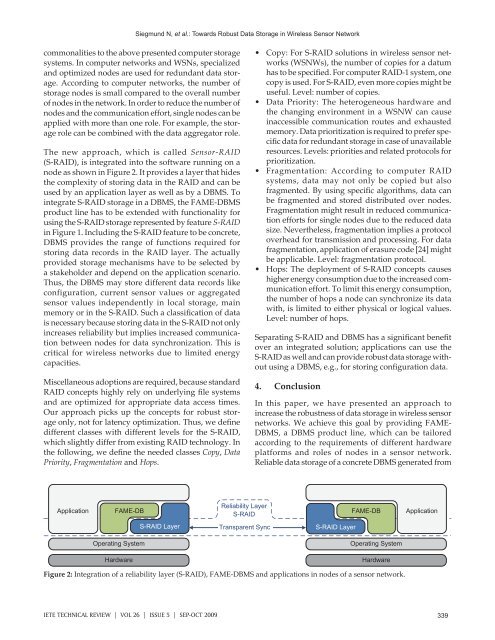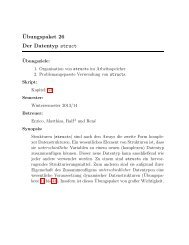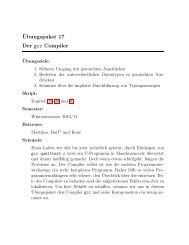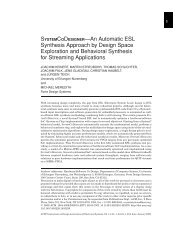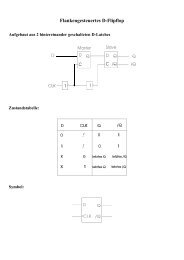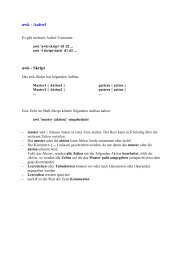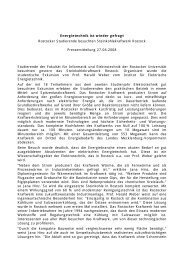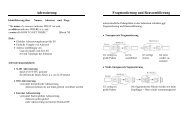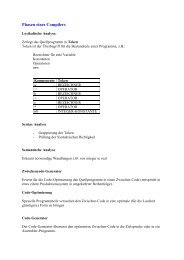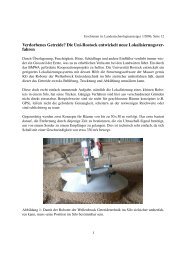Towards Robust Data Storage in Wireless Sensor Networks
Towards Robust Data Storage in Wireless Sensor Networks
Towards Robust Data Storage in Wireless Sensor Networks
Create successful ePaper yourself
Turn your PDF publications into a flip-book with our unique Google optimized e-Paper software.
Siegmund N, et al.: <strong>Towards</strong> <strong>Robust</strong> <strong>Data</strong> <strong>Storage</strong> <strong>in</strong> <strong>Wireless</strong> <strong>Sensor</strong> Network<br />
commonalities to the above presented computer storage<br />
systems. In computer networks and WSNs, specialized<br />
and optimized nodes are used for redundant data storage.<br />
Accord<strong>in</strong>g to computer networks, the number of<br />
storage nodes is small compared to the overall number<br />
of nodes <strong>in</strong> the network. In order to reduce the number of<br />
nodes and the communication effort, s<strong>in</strong>gle nodes can be<br />
applied with more than one role. For example, the storage<br />
role can be comb<strong>in</strong>ed with the data aggregator role.<br />
The new approach, which is called <strong>Sensor</strong>-RAID<br />
(S-RAID), is <strong>in</strong>tegrated <strong>in</strong>to the software runn<strong>in</strong>g on a<br />
node as shown <strong>in</strong> Figure 2. It provides a layer that hides<br />
the complexity of stor<strong>in</strong>g data <strong>in</strong> the RAID and can be<br />
used by an application layer as well as by a DBMS. To<br />
<strong>in</strong>tegrate S-RAID storage <strong>in</strong> a DBMS, the FAME-DBMS<br />
product l<strong>in</strong>e has to be extended with functionality for<br />
us<strong>in</strong>g the S-RAID storage represented by feature S-RAID<br />
<strong>in</strong> Figure 1. Includ<strong>in</strong>g the S-RAID feature to be concrete,<br />
DBMS provides the range of functions required for<br />
stor<strong>in</strong>g data records <strong>in</strong> the RAID layer. The actually<br />
provided storage mechanisms have to be selected by<br />
a stakeholder and depend on the application scenario.<br />
Thus, the DBMS may store different data records like<br />
configuration, current sensor values or aggregated<br />
sensor values <strong>in</strong>dependently <strong>in</strong> local storage, ma<strong>in</strong><br />
memory or <strong>in</strong> the S-RAID. Such a classification of data<br />
is necessary because stor<strong>in</strong>g data <strong>in</strong> the S-RAID not only<br />
<strong>in</strong>creases reliability but implies <strong>in</strong>creased communication<br />
between nodes for data synchronization. This is<br />
critical for wireless networks due to limited energy<br />
capacities.<br />
Miscellaneous adoptions are required, because standard<br />
RAID concepts highly rely on underly<strong>in</strong>g file systems<br />
and are optimized for appropriate data access times.<br />
Our approach picks up the concepts for robust storage<br />
only, not for latency optimization. Thus, we def<strong>in</strong>e<br />
different classes with different levels for the S-RAID,<br />
which slightly differ from exist<strong>in</strong>g RAID technology. In<br />
the follow<strong>in</strong>g, we def<strong>in</strong>e the needed classes Copy, <strong>Data</strong><br />
Priority, Fragmentation and Hops.<br />
• Copy: For S-RAID solutions <strong>in</strong> wireless sensor networks<br />
(WSNWs), the number of copies for a datum<br />
has to be specified. For computer RAID-1 system, one<br />
copy is used. For S-RAID, even more copies might be<br />
useful. Level: number of copies.<br />
• <strong>Data</strong> Priority: The heterogeneous hardware and<br />
the chang<strong>in</strong>g environment <strong>in</strong> a WSNW can cause<br />
<strong>in</strong>accessible communication routes and exhausted<br />
memory. <strong>Data</strong> prioritization is required to prefer specific<br />
data for redundant storage <strong>in</strong> case of unavailable<br />
resources. Levels: priorities and related protocols for<br />
prioritization.<br />
• Fragmentation: Accord<strong>in</strong>g to computer RAID<br />
systems, data may not only be copied but also<br />
fragmented. By us<strong>in</strong>g specific algorithms, data can<br />
be fragmented and stored distributed over nodes.<br />
Fragmentation might result <strong>in</strong> reduced communication<br />
efforts for s<strong>in</strong>gle nodes due to the reduced data<br />
size. Nevertheless, fragmentation implies a protocol<br />
overhead for transmission and process<strong>in</strong>g. For data<br />
fragmentation, application of erasure code [24] might<br />
be applicable. Level: fragmentation protocol.<br />
• Hops: The deployment of S-RAID concepts causes<br />
higher energy consumption due to the <strong>in</strong>creased communication<br />
effort. To limit this energy consumption,<br />
the number of hops a node can synchronize its data<br />
with, is limited to either physical or logical values.<br />
Level: number of hops.<br />
Separat<strong>in</strong>g S-RAID and DBMS has a significant benefit<br />
over an <strong>in</strong>tegrated solution; applications can use the<br />
S-RAID as well and can provide robust data storage without<br />
us<strong>in</strong>g a DBMS, e.g., for stor<strong>in</strong>g configuration data.<br />
4. Conclusion<br />
In this paper, we have presented an approach to<br />
<strong>in</strong>crease the robustness of data storage <strong>in</strong> wireless sensor<br />
networks. We achieve this goal by provid<strong>in</strong>g FAME-<br />
DBMS, a DBMS product l<strong>in</strong>e, which can be tailored<br />
accord<strong>in</strong>g to the requirements of different hardware<br />
platforms and roles of nodes <strong>in</strong> a sensor network.<br />
Reliable data storage of a concrete DBMS generated from<br />
<br />
<br />
<br />
<br />
<br />
<br />
<br />
<br />
<br />
<br />
<br />
<br />
<br />
Figure 2: Integration of a reliability layer (S-RAID), FAME-DBMS and applications <strong>in</strong> nodes of a sensor network.<br />
IETE TECHNICAL REVIEW | Vol 26 | ISSUE 5 | SEP-OCT 2009<br />
339


